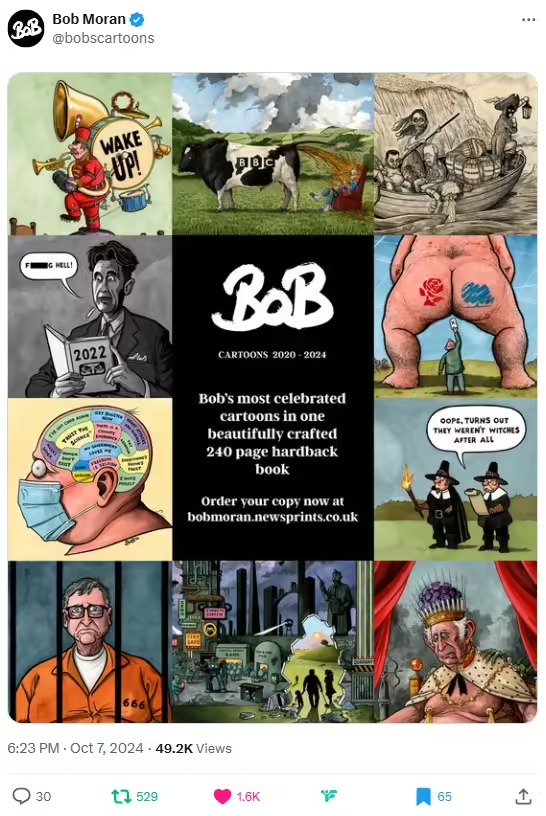The Power of Visual Storytelling
In today's fast-paced world, the ability to communicate complex ideas in a simple and engaging way is more important than ever. Cartoons, with their unique blend of humor, satire, and visual storytelling, offer a powerful tool for social change.
One artist who has mastered the art of using cartoons for social commentary is Bob Moran, whose new book is a testament to his talent and commitment to making a difference. Cartoons have the ability to break down barriers and reach a wider audience than traditional forms of communication. Their simple visuals and concise messages can transcend cultural and linguistic boundaries, making them a powerful tool for fostering understanding and empathy.
Bob's Cartoons: A Catalyst for Change
Bob's work is a testament to the power of cartoons to spark dialogue, raise awareness, and inspire action. His illustrations often tackle complex social issues with a touch of humor and satire, making them both entertaining and thought-provoking.
Exploring Bob's Themes
Bob's cartoons often explore a variety of themes, including:
- Social inequality: His work highlights the disparities in society and challenges us to question the status quo.
- Environmental issues: Bob uses his cartoons to raise awareness about climate change, pollution, and other environmental concerns.
- Human rights: Bob's cartoons have addressed issues such as racism, sexism, poverty, advocating for equality and justice.
- Political satire: His illustrations often poke fun at politicians and government policies, encouraging critical thinking and engagement.
The Impact of Bob's Work
Bob's cartoons have had a significant impact on social discourse. His work has sparked conversations, inspired artivism resulting in activism, and challenged people to think critically about the world around them.
The Role of Cartoons in Social Justice
Cartoons have a long history of being used for social commentary and activism. From political cartoons lampooning corrupt leaders to comic strips highlighting social inequalities, these illustrations have played a crucial role in sparking movements and advocating for change.
How Can You Use Cartoons for Change?
Whether you're a seasoned artist or just starting out, you can harness the power of cartoons for social good. Here are some ideas:
- Create your own cartoons: If you have artistic talent, use it to create your own social commentary cartoons and share them online or with your community.
- Support cartoonists for change: Follow and share the work of cartoonists who advocate for social justice.
- Start a conversation: Use cartoons as a springboard for discussions about important issues.
Bob's Artistic Style and Techniques
Bob has developed a unique artistic style that combines humor, satire, and visual storytelling. His use of bold colors, exaggerated features, and clever wordplay makes his cartoons instantly recognizable.
- Humor and Satire: Bob's ability to find humor in even the most serious situations is a hallmark of his work. His cartoons often use satire to expose the absurdity of societal problems.
- Visual Storytelling: Bob's illustrations are carefully crafted to convey a message without relying solely on words. His use of symbolism, metaphor, and exaggeration adds depth and meaning to his work.
- Character Development: Bob's cartoons often feature recurring characters who embody different aspects of society. These characters help to humanize complex issues and make them more relatable.
The Future of Cartoons for Social Change
As technology continues to evolve, the potential for cartoons to impact social change is only growing. Social media platforms have made it easier than ever for artists to share their work and reach a global audience.
In the future, we can expect to see even more innovative and powerful uses of cartoons for social justice. Whether it's through virtual reality experiences, interactive storytelling, or other emerging technologies, the potential for cartoons to inspire and educate is limitless.
Conclusion
Bob's Cartoons' new book is a testament to the power of visual storytelling and the impact it can have on social change. By using humor, satire, and a universal language, cartoons can reach a broad audience and inspire action.
As we continue to navigate a complex world, it's more important than ever to have tools that can bridge divides and spark meaningful conversations. Cartoons offer a unique and powerful way to do just that. We've just received Bob Cartoons book at our Head Office today and we absolutely love it!
The Peoples Hub

